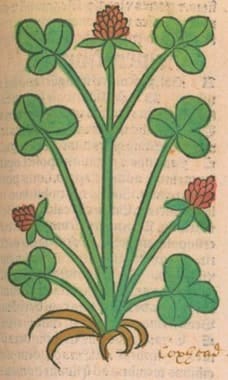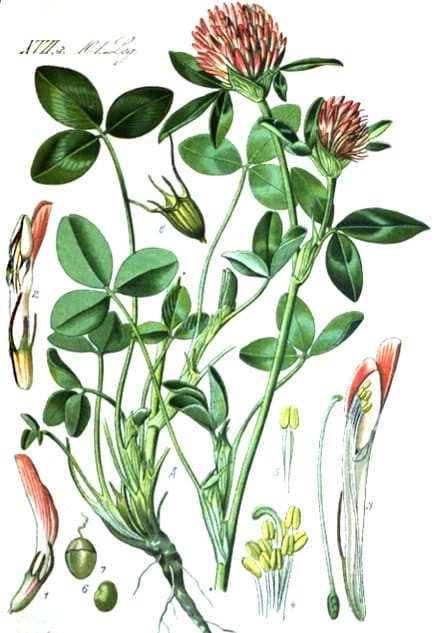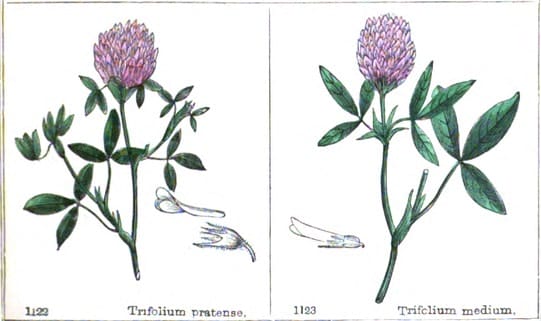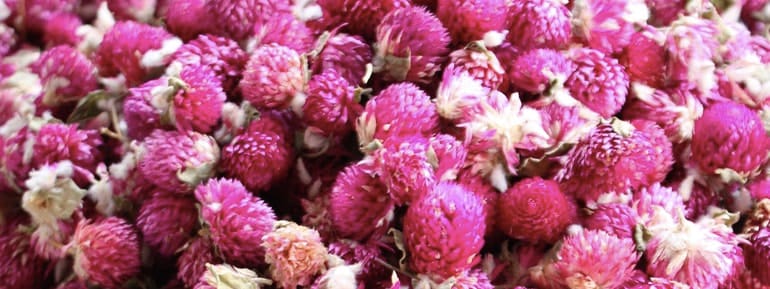Trifolium, Red Clover
 Ortus Sanitatis, Meydenbach, 1491
Ortus Sanitatis, Meydenbach, 1491 T. pratense
T. pratenseFlora von Deutschland (23), Kohler, 1885
 Florigraphia Britannica, Deakin, 1857
Florigraphia Britannica, Deakin, 1857 Red Clover Flower (Adam, 2017)
Red Clover Flower (Adam, 2017)Botanical name:
Trifolium pratense, T. medium; T. repens is the White
Parts used:
Flowers
Temperature & Taste:
Cool, dry. Slightly Sweet and Bitter
Classification:
B. Clear Heat, Cools the Blood
Uses:
1. Clears Blood Heat, Nourish the Yin:
-heat conditions where the fluids have been damaged
-Deficient Heat
-Tuberculosis
-thirst and dehydration associated with these conditions
-heat-type Rashes, Sores, Gout and Joint Pain.
-Russians have traditionally used it for Emaciation, Anemia, Asthenia and Diabetes Mellitus, all associated with Yin deficiency.
-lower back pain, and for those who are overworked, with mental fatigue, confusion, failing memory
-reputation to slow baldness.
2. Clears Heat, Benefits the Blood, Regulates Menstruation:
-promotes the onset of Menstruation, ease cramps, and to treat Uterine hemorrhage.
-female Infertility
-symptoms of Menopause
-beneficial for women
-used to promote healthy tissue granulation, and benefits in Anemia.
-reduces cholesterol, and is useful in Atherosclerosis.
3. Clears Heat, Moves the Blood, Resolves Swellings:
-Swellings, Scrofula, Tumors
-inflammation of the Ovaries
-Fibroid Tumors and Cancers (used both internal and external);
-Skin Cancers
-‘The Flowers infused in Oil … for malignant ulcers’.
4. Clears Wind-Heat, Resists Poison (West, TCM):
-Snake Bite and other venomous bites
-Syphilis
-onset of Colds and Flu
-Hayfever;
-other allergic conditions including Vitiligo, Eczema etc.
-chronic toxic conditions including Heavy Metal poisoning.
-The juice has been used traditionally for Jaundice in Russia.
5. Clears Phlegm and Heat, Stops Cough (West, TCM):
-spasmodic Coughs, Whooping Cough, Asthma, Bronchitis
-Cough of Measles
-best for hot, dry, irritable Coughs and lung conditions.
6. Externally:
-The whole herb is made into a poultice and applied to inflammations, sores, ulcers etc.
-juice is dropped into the eyes to ease the heat and redness of them and also for the ‘pin and web’.
-Poultices are applied to Burns and Scalds, Swellings, Tumors and Cancers
-Dermatitis, Rashes
-juice rubbed into the scalp can return color to greying hair. (Red or White may be used)
Dose:
Larger doses than these may be gradually built up to; up to 4 times the given doses may be taken.
Infusion or Short Decoction: 5-15 grams, up to 30 grams or more (20-50 grams of the fresh). 1-2 oz. per day is used for infertility and Cancer, with up to 3 or 4 oz. being taken daily for Cancer in some cases, and its use is often continued for over a year;
Fresh Juice: 5-10, or 15mls, 2-3 times daily, increasing if needed;
Tincture (1:5): 2-4, or 6 mls;
Fluid Extract (1:1): 2-4 mls.
Main Combinations:
1. Cancer:
i. Red Clover with Burdock root, Poke root, Sarsaparilla, Peach bark, Licorice (as in the Hoxey Cancer formula)
ii. Red Clover with Violet, Burdock, Yellow Dock, Dandelion, Golden Seal. This was said to have cured 15 cases of Cancer (Golden Remedies: Knowledge is Power, 19th Century)
2. Eczema, Psoriasis:
i. Red Clover with Cleavers, Nettle, Figwort
ii. Red Clover with Cleavers, Yellow Dock, Red Clover and Nettle
iii. Red Clover with Heart’s Ease, Yellow Dock, Cleavers and Nettle
3. Syphilis, Red Clover with Burdock seed, Oregan Grape root, Blood root
4. To promote and increase quality of Breast Milk, Red Clover with Aniseed, Sesame seed, Fennel seed, Poppy seed (as in Powder for Defect of Milk)
5. Female Infertility, Red Clover with Raspberry leaf
6. Wash for Sores and Ulcers, Red Clover with Yellow Dock
Major Formulas:
Plaster of Red Clover
Cautions:
Generally Safe.
Drug Interactions:
1. Any Cancer which may be aggravated by Estrogen therapy are best not be treated with Red Clover. These include some breast and uterine cancers.
2. Red Clover may increase effectiveness of Warfarin (this does not mean that they cannot be used together, but the patient should be monitored in case Warfarin dosage can be reduced).
Main Preparations used:
Cancer Plaster
1. Cancer Plaster:
i. Red Clover Blossoms 1 oz.
Simmer in 2 pints of distilled Water for 1 hour. Strain, add another oz. of Red Clover, and slowly boil another hour. Strain again and simmer until liquid is drawn off. Avoid burning. When it has reached a thick consistency, remove from the heat and jar. It will harden as it cools. Apply to the part, and cover with a cloth or dressing.
ii. ‘Take of red clover blossoms any desirable quantity, and water sufficient to cover them; boil gently until the strength of the blossoms is extracted, which will be in about an hour; strain through a coarse cloth, and use pressure sufficient to force out all the liquid; pour this into some convenient vessel, and place it in a kettle of water over the fire; boil until the liquid is of the consistence of tar. Spread this on a piece of linen, or soft leather. It is one of the best applications for open or running cancers and ill-conditioned sores or ulcers of every description, deep, ragged-edged and other wise badly conditioned burns’. (Guide to Health, B. Colby, 1846)
Treatment of Cancer:
‘Out of 15 cases of Cancer that my brother Physicians have abandoned as incurable, I have cured with this Wonderful remedy, Red Clover tops’ (Golden Remedies: Knowledge is Power, 19th Century).
Treatment of Breast Cancer.
‘The New York Tribune of September, 1884, related a case of indisputable cancer of the breast of six years standing, with an open fetid sore, which had penetrated the chest-wall between the ribs, and which was radically healed by a prolonged internal use of the extract of red clover. Four years afterwards, in September, 1888, “the breast was found to be restored to its normal condition, all but a small place the size of half a dollar, which will in every probability become absorbed like the rest, so that the patient is considered by her physicians to be absolutely cured.” (Herbal Simples Approved for Modern Uses of Cure, W. T. Fernie, M.D., 1897)
